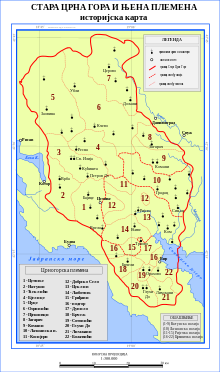Ozrinići (tribe)
| Part of a series on |
| Tribes of Montenegro |
|---|
 |
Ozrinići (Serbian Cyrillic: Озринићи) is a historical tribe (pleme) and region in Montenegro. During the Ottoman period, it was one of the largest tribe of the Katunska nahija, one of the four territorial units of Old Montenegro.
History[edit]
The first reference to the Ozrinići comes from a letter issued by the Serbian Chancellery in Dubrovnik in 1411. The document, a complaint from Ragusan people addressed to Jelena Balšić, is about the looting committed by the Ozrinići, together with the Bjelopavlići, Maznice and Malonšići, on Ragusan merchants on their way through Zeta while they were returning from Serbia.[1]
The Ozrinići are mentioned again in the 1489 charter of Ivan Crnojević, then in the 1570–1571 defter of the Sandjak of Peć. Five families of the Ozrinići founded the settlement of Ozrinići in the Nikšić area in 1597.[2]
During the Ottoman period, from the 16th up to the end of the 18th century, the Ozrinići were the largest tribe of the Katunska nahija, one of the four territorial units of Old Montenegro.[2]

In 1829, the Ozrinići and Cuce had an armed conflict against neighboring Bjelice. Petar I Petrović-Njegoš sent Sima Milutinović Sarajlija and Mojsije to negotiate peace among them.[3]
Anthropology[edit]
According to Kovijanić, the Ozrinići were an old Serb tribe. Their founder was Ozro, who moved from Zeta and his descendants formed the Ozrinići tribe.[4] Ozrinići included the villages of Barjamovica, Velestovo, Markovina, Maklen, Čevo, Ploča, Lastva, Ožegovići.[5] All Ozrinići celebrate the slava (feast) of Aranđelovdan (Michael).[6]
Notable people[edit]
- Milena Vukotić
- Sula Radov Radulović
- Janko Vukotić
- Dušan Vukotić
- Momčilo Vukotić
- Petar Vukotić
- Vito Nikolić
- Živko Nikolić
- Milo Đukanović
- Aco Đukanović
- Željko Šturanović
- Žarko Varajić
- Vojo Gardašević
- Blažo Perutović
- Rođa Raičević
- Pop Milo Jovović
- Brano Mićunović
- Dragoljub Mićunović
- Peko Pavlović
- Dušan Spasojević
- Andrija Drašković
- Branko Radulović (Montenegrin politician)
- Saša Radulović
References[edit]
- ^ Stojanović, Ljubomir, ed. (1929). Stare srpske povelje i pisma [Old Serbian charters and letters] (in Serbian). Vol. I/1. Belgrade: Srpska Kraljevska Akademija. p. 387.
- ^ a b Петар Влаховић. Гласник Етнографског музеја у Београду, књ. 64. Etnografski muzej u Beogradu. pp. 231–. GGKEY:7LRL4EYK77W.
- ^ Miloš Oben; Michel Aubin (1989). Njegoš i istorija u pesnikovom delu. Književne novine. p. 63. ISBN 9788639101480. Retrieved 7 May 2013.
Бјелице су племе у Катунској нахији. Водили су 1829. оружану бор- бу са два суседна племена, Озринићима и Цуцама. Да би успоставио мир, Петар I је решио да им пошаље Симу Милутиновића и Мојсија
- ^ Kovijanić 1974, p. 218.
- ^ Kaiserl. Akademie der Wissenschaften in Wien; Österreichische Akademie der Wissenschaften. Philosophisch-Historische Klasse (1987). Schriften der Balkankommission, Linguistische Abteilung. Alfred Hölder.
- ^ Vidak Vujačić (1980). Etos Crnogorke: tradicionalni oblici i sadržaji u životu Crnogorke. NIO "Pobjeda," OOUR Izvadačko-publicistička djelatnost.
Na primjer, svi Ozrinići slave Aranđelovdan. Neorganizovanija plemena, pak, nijesu imala zajedničku slavu, kao na primjer: Crmničani, Njeguši, Cuce, Bjelice, Ceklići, Grahovljani, Kuči, Rudinjani i drugi. Naravno, svako posebno bratstvo u ...
Sources[edit]
- Nebojša B. Drašković (1999). Čevsko Zaljuće i Donji Kraj sela u plemenu Ozrinići. Odbor za proučavanje sela SANU, kulturno-prosvetna zajednica Republike Srbije.
- Petar Pejović; Mihailo Burić; Novak Ražnatović; Drago Ćupić (2004). Ozrinići: pleme stare Crne Gore. P. Pejović. ISBN 978-86-905597-0-1.
- Kovijanić, Risto (1974). Crnogorska plemena u kotorskim spomenicima (XIV–XVI vijek) [Montenegrin tribes in Bay of Kotor records (XIV–XVI century)]. Titograd: Istorijski institut SR Crne Gore.
